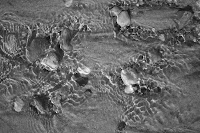At the start of winter break I realized that I hadn't posted anything during December
(due mostly to an obscene quantity of homework as well as my loss of interest in
writing about nature photography since I did not have time to do it anyway), so I
decided to wait out the rest of the month and spend winter break accumulating more
material. For winter, the biome of the North Shore was set with snow, ice, cold, and
holiday decor--providing an interesting new scene to explore. Yesterday I travelled
around to a few places that would have unique wintry landscapes, and stopped by
Maple Beach in Winnetka to photograph the small ridge of ice which had formed atop
the sand on the shore.
The icy water flung a mixture of snow and sand onto the protruding cliff and in the
top photograph broke off blocks of ice as it burst up the ridge's slope. I went to
the beach with no intention of capturing that shot but was drawn to it after a trial and
error process where I took progressively less and less wide angle shots and narrowed
onto the most intriguing or eye-catching component of the landscape. Even then,
I crouched in the icy sand and stared through the camera's viewfinder at the spot where
water seemed to be crashing most for at least ten minutes per crag of ice, tarrying
until the water splashed to a noticeable height. With the top photograph, I was lucky
enough to capture the wave actually removing and throwing two pieces of the ice.
Winnetka
Taken in January 2013























